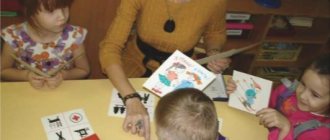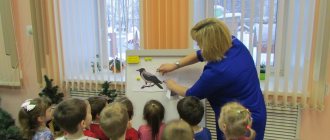Goals and objectives of environmental education for preschool children
— From simple to more complex
— From the particular to the more general
The process of forming the foundations of environmental knowledge in children can be conditionally divided into several stages, following each other or in parallel and allowing to create the most complete picture of the world. In this case, it is necessary to take into account the age characteristics and general level of development of the children in the group.
Approximate sequence for presenting environmental knowledge:
— Nature and objects made by human hands.
- Living nature: humans, all animals, all plants. Signs of a living organism: eats, breathes, moves, grows, reproduces.
— Inanimate nature is a habitat for all living things: terrestrial, underwater, air.
— Interrelation and interdependence of living beings with the environment: features of the external structure that contribute to adaptation to environmental conditions, adaptation to environmental changes by season; molting, food reserves for the winter, hibernation, leaf fall of plants, etc., ecosystems (biocenoses) and their types: ecosystems of forests, meadows, lakes, seas and others.
By daily revealing to a child the beauty, uniqueness and essence of certain natural objects and phenomena, one can form a stable interest in the surrounding nature and develop artistic and creative abilities. Observing in nature, children reflect everything they saw and felt in their drawings, crafts made from paper, plasticine, natural materials, as well as in play activities.
In the process of environmental education, children's speech develops. This is very important for every child and is especially important for children in speech therapy groups with general speech underdevelopment (GSD). This starts from the selection of adjectives when describing natural objects and ends with children inventing stories, fairy tales, and riddles on environmental topics.
When forming concepts and ideas about natural objects, about various natural phenomena, it is necessary to constantly show that in nature everything is connected, everything depends on each other. If, under the influence of some factors, changes occur in one link, then changes occur in many other links along the chain, leading to undesirable and often harmful consequences, both for nature and for man himself. By introducing children to the negative impacts of humans on nature, revealing the integrity of nature, it is necessary to instill in them a sustainable need for a caring and careful attitude towards the entire world around them, a desire to preserve and increase its wealth. If such needs are firmly established in children, then this will be the beginning of the formation of the foundations of an ecological culture in them, which is part of the general culture of a person’s personality.
Ecological-subcultural practices in environmental education of preschool children.
Ecological-subcultural practices in environmental education of preschool children.
Dunaeva Yulia Alexandrovna
teacher
MBDOU kindergarten "Solnyshko"
Sechenovsky district
Nizhny Novgorod Region
Intensive educational work to develop environmental consciousness among the population begins in kindergarten - in the first link of the system of continuous environmental education.
Preschool childhood is the initial stage of the formation of a person’s personality and his value orientations in the world around him. During this period, a positive attitude towards the man-made world, oneself and the people around him is formed. The basis of environmental education is the formation in a child of a consciously correct attitude towards the natural objects that surround him and with which he becomes acquainted in preschool childhood.
Children's consciously correct attitude towards nature is based on their sensory perception, emotional attitude, knowledge of the characteristics of life, growth and development of individual living beings, some biocenoses, knowledge of adapted dependencies on environmental factors, relationships within natural communities (food connections). The conscious nature of the relationship is manifested in the fact that children themselves can explain the situation or understand the adult’s explanation. They can independently or with the help of an adult identify individual labor actions, understanding the situation and knowing the needs of a living being, which are aimed at preserving and improving the lives of animals and plants.
The process of developing a consciously correct attitude towards nature is accompanied by certain forms of child behavior, which serve as criteria for assessing his environmental education (ecological culture).
Ecological culture is a set of views on nature, a conscious attitude towards it, which is reflected in human behavior and all of his practical activities.
The “repository” of traditional ecological culture is the ecological subculture of children.
To date, various aspects of children's subcultural characteristics are presented in the studies of V.V. Abramenkova, M.A. Kozlovskaya, E.Yu. Kopeikina, E.E. Sapogova, E.O. Smirnova and R.E. Radeva, M.V. Osorina. The meaning and significance of childhood and children's subculture as a socio-historical phenomenon are considered by A. Barkan, M.D. Donaldson, W.T. Kudryavtsev, V.D. Shadrikov and others.
The ecological subculture as a form of existence is described by A.D. Kleshchev, and G.P. Sikorskaya sees the ecological subculture as an educational system complex. The ecological subculture of Childhood and the child’s self-development in it is studied by V.A. Zebzeeva.
The main pedagogical condition contributing to the formation of an ecological subculture of children in the preschool education system is the use of environmental and subcultural practices of Childhood.
Ecological-subcultural practices are situational, autonomous, independent, initiated by adults, peers or the child himself, the acquisition and repetition of various cultural experiences of communication and interaction with nature in various groups, teams, communities and social structures - with adults, peers, younger or older children . This is also the development of positive life experiences of empathy, goodwill, love, friendship, care, assistance to natural objects, as well as the formation of a negative attitude towards manifestations of dissatisfaction, resentment, and rudeness by someone in relation to natural objects.
Ecological and subcultural practices used in preschool educational institutions:
1. Arrangement of the child’s own ecological cultural environment.
2. Information-rich verbal and substantive communication with educators and peers.
3. Practice questioning, the beginning of reflection (ask a question of environmental content and find an answer to it).
4. Practice of knowledge and independent learning.
5. Moral standards for the practice of communication and interaction with nature.
6. Formation of character and self-will (the desire and ability to act for the benefit of nature, despite one’s desires).
7. Habitual participation in environmental activities and work in nature.
8. Cultural space of natural history reading.
9.Ecological creativity.
10. Examination of illustrations, reproductions, albums.
11. Playing music and mastering the elementary foundations of musical culture.
12. Regular listening and free singing of songs about nature.
13. Ecologically oriented physical activity.
14. Collecting.
15. Visiting cultural institutions and cultural events.
16. Television and computer - replacing modern cartoons traditionally loved by children with those that glorify nature and a literate, caring, and thrifty person in relation to nature.
Ecological-subcultural practices involve the inclusion of the child in solving problematic environmental situations of development in order to acquire environmental experience; implementation of the knowledge and experience accumulated by the child in specially organized and non-regulated activities or situations, in the surrounding pedagogical, social or natural environment.
Ecological culture as a quality of personality is formed both in the process of pedagogical interaction and during the spontaneous formation and activity of the individual himself; each of the designated practices will include the child’s initiative and cultural forms created by adults for the child, reflecting signs, symbols, images of nature.
Literature:
1. Zebzeeva, V.A., Moiseeva, L.V. Ecological development of personality in the humanistic paradigm of preschool education: monograph / V.A. Zebzeeva, L.V. Moiseeva; State Educational Institution of Higher Professional Education “Ural. state ped. univ." – Ekaterinburg, 2008. – 169 p.
2. Kopeikina, E.Yu. Subculture of childhood: abstract. dis. for the job application scientist step. Ph.D. cultural studies: (24.00.01) / Kopeikina Elena Yurievna. - Nizhny Novgorod, 2000. - 31 p.
3. Krylova, N.B. Cultural practices of childhood and their role in the formation of the child’s cultural idea / N.B. Krylova //New values of education (Identity of childhood). - 2007. - No. 3. — P.79-108.
4. E.V. Mikheeva. Ecological-subcultural practices in environmental education of preschool children. News of the Volgograd State Pedagogical University. – 2009. – No. 6 (40). – С147-150 s.
Where does the formation of environmental awareness among preschoolers begin in preschool educational institutions?
The first step is to create conditions for this work: a corner of nature with an aquarium, small animals in a group, a small winter garden, a nature museum. A living area can contain birds, fish, reptiles, and small animals.
The guys feed them, clean them, observe them, and study their characteristics. Walks are also important, when children observe and draw conclusions about certain phenomena in living and inanimate nature.
The role of parents in environmental education cannot be belittled. Now families have cats, dogs, parrots, and turtles. There are aquariums and indoor plants. Adults should daily introduce children to the world of nature, to comprehend its secrets, so that from early childhood a feeling of unity with the world around them arises.
Environmental education in kindergarten
Already at a young age, the baby begins to interact with peers, with adults, with objects of nature.
The child shows curiosity, asks why questions, and adopts the values and traditions of elders. Ages from 3 to 6 years are the most susceptible. A preschooler learns the experience of adults based on trust in them. From an early age he learns to actively cooperate with nature and empathize with it.
Environmental education starts in the family and continues in the nursery. Each preschool institution draws up its own program for the formation of environmental knowledge, covering the entire educational process, starting with a walk and ending with educational activities.
Environmental education
Now about the concept of “ecological education”. In the pedagogical literature one can find many definitions of the concept “education”. Therefore, in order to avoid discrepancies, let us remember that in the law “On Education in the Russian Federation” (2014), education is considered as a single process of upbringing and training.
In this case, environmental education includes environmental education and environmental training.
By environmental education we mean the formation in children of environmental ideas, corresponding skills, and methods of action; by environmental education we mean the formation and development of environmental emotional-value relationships.
In other modern sources, including those related to preschool education [6], the concept of “education” includes development along with training and upbringing.
Taking into account the above, environmental education can be defined as the process of training, education and development of a person (child) in the field of his relationship with the natural environment .
(Here it is necessary to note that many teachers adhere to old terminological concepts and in their development of educational activities distinguish the goals of education, the goals of upbringing and the goals of development, which in the light of the above is logically incorrect: the goals of education already include the implementation of educational goals and development goals.)
The goal of environmental education is the formation of an environmental culture. The concept of “ecological culture” is multifaceted. It includes, in particular, the presence of environmental consciousness and ecological thinking in a person. Neither one nor the other can be formed in preschoolers. Therefore, when working with them, we can only talk about the prerequisites or the beginning of the formation of an ecological culture.
Principles and models of environmental education
In the theory of environmental education, the principle of interdisciplinarity was one of the first to be formulated, which involves the formation of environmental knowledge, skills, and relationships in the process of studying all or almost all academic disciplines. In relation to preschool education, this principle directs teachers to implement environmental education within the framework of all educational areas named in the Federal State Educational Standard.
Currently, three models of environmental education : single-subject, multi-subject and mixed.
- The one-subject model is implemented within the framework of a special environmental course (in preschool education this is “Young Ecologist”, etc.) or an integrated environmental discipline.
- The multi-subject model is implemented by saturating all or almost all academic disciplines with environmental material.
- The mixed model involves the study of environmental issues in each academic subject and holistically in a special subject (subjects).
Obviously, a mixed model is most effective.
Ecological approach in the education of preschool children
The content of environmental education for preschoolers includes knowledge related to one or another section of scientific ecology. For example, in the approximate main program “World of Discovery” it is assumed that the formation of primary ideas that in nature everything is interconnected, and man is part of nature, as well as the interconnections and interactions of living organisms with their environment [4].
However, much greater opportunities for the environmental education of children are not the actual environmental content of programs or classes, but the implementation by the teacher of an environmental approach in education.
An ecological approach is understood as the inclusion of environmental aspects in most issues discussed with children, the correlation of the objects being studied with a person, his behavior, and activities. S.N. Nikolaeva includes an “ecological approach” in the definition of the concept of “ecological education of preschool children”: “... this is an introduction to nature, which is based on an ecological approach, when the pedagogical process is based on the fundamental ideas and concepts of ecology” [2].
In the same work, S.N. Nikolaeva has sections “Ecological approach to understanding diversity in living nature”, “Ecological approach in streamlining ideas about diversity in living nature”. It is clear that the use of the ecological approach is not limited to this alone.
Almost any natural science and sometimes social science issue under consideration can also include an environmental component. For example, when studying a plant, not only its appearance or structure is considered, but also the influence of environmental factors on its growth and development: moisture, light, heat. When studying natural areas, not only the peculiarities of climate, flora and fauna are discussed, but also questions of adaptation of organisms to environmental conditions (for example: why does the dwarf birch have a shallow root system, a low curved trunk? Why is a bear living in an icy desert white? etc. .P.).
Age-related characteristics of preschoolers’ attitudes toward nature
They must be taken into account in children's education. After birth, the child is unable to identify himself and his environment. Even J. Piaget established that the main feature of a preschooler’s attitude to the world is egocentrism. The child does not clearly differentiate his self and the world around him, the subjective and the objective, and transfers his own motives to the real connections between the phenomena of the world. The result is anthropomorphism, i.e. endowing objects and phenomena of the surrounding world with properties inherent in the child himself. This feature of perception is largely preserved in younger schoolchildren, and partly in adults.
And after the child begins to realize the difference between his Self and the surrounding objects and phenomena, for some time he still does not divide the environment into natural, man-made and social. Children transfer relationships in the world of people to relationships in the world of nature and in the world of things. This is manifested in personification. Personification is the endowment of objects and natural phenomena with qualities and properties of a certain type of person: for example, a fox with cunning, a hare with cowardice. Such relationships largely persist among younger schoolchildren, often later.
In the early stages of a child’s development, the teacher supports the anthropomorphization of nature, encourages empathy with animals and plants: “don’t touch the kitten - it hurts just like you,” “don’t break the branches - it hurts the plant.”
An example of a game situation: the teacher turns to the children with a proposal to respond to the received telegram.
“We are the first green, and for this we are broken. Everyone who doesn’t care about the forest breaks it. We are even afraid to be the first to bloom in the forest. So what's so good about it? They'll break it anyway. Help us! It really hurts when you get broken! Very! Your green friends: Willow, Bird Cherry, Forest Lilac.” (According to V. Bianchi. “Telegrams from the Forest.”)
When working with older preschoolers, environmental information begins to be introduced into the content of a game built on the humanization of nature. Here is an example of a game situation similar to the one described above.
The teacher reads a telegram from the forest.
"I need help! Urgent! The beetles came out, climbed the trees, chewed everything. In winter they sat in the ground - they hid two meters deep, and now they attacked the trees. I work for two people, but I still can’t cope: there are a lot of them. Need urgent help! Pass this on to the kids. Urgently. Your Woodpecker."
Here children already get an idea of the relationship between birds and insects, and the ecological role of the woodpecker.
The mentioned features of children's perception of natural objects (humanization, personification) provide an opportunity for the integration of environmental education itself and moral education.
Effective environmental education through play activities
Through the game, the understanding of the life of plants and animals gained during excursions and direct contact with the inhabitants of the meadow, forest, and pond is consolidated.
Ecological game technology:
- Selecting a topic from the program.
- Determining the purpose and conditions of the game.
- Thinking through the stages of the game.
- Distribution of roles.
- Getting to know the rules.
The method of teaching such games depends on the characteristics of the preschooler’s age. There are different types of games: subject, board, verbal, creative. When creating creative game situations, you can use fairy-tale characters.
For example, Little Red Riding Hood goes to her grandmother through the forest and can meet its different inhabitants and collect leaves of forest trees. Toys are important for games: dolls, fish, animals. They should be aesthetic, bright, realistic. In this case, the game stimulates the activity of children and increases their emotional mood.
Problems of environmental education
The main problem in this direction is the low equipment of gardens. Conditions are necessary to create a winter garden and mini-laboratories. To carry out gaming activities, you need didactic materials, maps, manuals, models, toys.
The second problem is the viability of the developed education system. The environmental education program and the entire methodology for environmental education of preschoolers will be implemented in the case when each stage of work and the result of the work are thought out: what we want the student to be like when he enters school.






